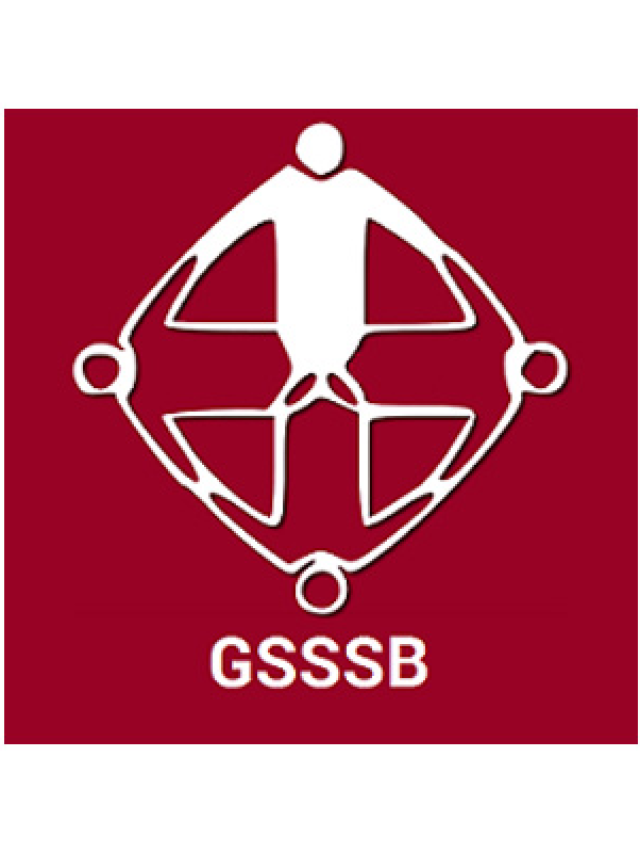| ( ! ) Warning: Undefined array key "blockId" in /home/kbxmjwdb/public_html/wp-content/plugins/table-of-contents-block/table-of-contents-block.php on line 159 | ||||
|---|---|---|---|---|
| Call Stack | ||||
| # | Time | Memory | Function | Location |
| 1 | 0.0003 | 354000 | {main}( ) | .../index.php:0 |
| 2 | 0.0004 | 354360 | require( '/home/kbxmjwdb/public_html/wp-blog-header.php ) | .../index.php:17 |
| 3 | 0.1645 | 10545128 | require_once( '/home/kbxmjwdb/public_html/wp-includes/template-loader.php ) | .../wp-blog-header.php:19 |
| 4 | 0.2886 | 18256888 | include( '/home/kbxmjwdb/public_html/wp-content/themes/generatepress/single.php ) | .../template-loader.php:106 |
| 5 | 0.3914 | 19759328 | generate_do_template_part( $template = 'single' ) | .../single.php:29 |
| 6 | 0.3914 | 19759328 | get_template_part( $slug = 'content', $name = 'single', $args = ??? ) | .../theme-functions.php:568 |
| 7 | 0.3914 | 19759848 | locate_template( $template_names = [0 => 'content-single.php', 1 => 'content.php'], $load = TRUE, $load_once = FALSE, $args = [] ) | .../general-template.php:206 |
| 8 | 0.3915 | 19759960 | load_template( $_template_file = '/home/kbxmjwdb/public_html/wp-content/themes/generatepress/content-single.php', $load_once = FALSE, $args = [] ) | .../template.php:745 |
| 9 | 0.3915 | 19760376 | require( '/home/kbxmjwdb/public_html/wp-content/themes/generatepress/content-single.php ) | .../template.php:812 |
| 10 | 0.3928 | 19808104 | the_content( $more_link_text = ???, $strip_teaser = ??? ) | .../content-single.php:73 |
| 11 | 0.3929 | 19808104 | apply_filters( $hook_name = 'the_content', $value = '<!-- wp:paragraph -->\n<p><strong>NCERT solutions for Class 9 Maths Chapter 6 Lines And Angles (updated)</strong></p>\n<!-- /wp:paragraph -->\n\n<!-- wp:table-of-contents-block/table-of-contents-block {"headers":[{"level":2,"content":"\\u003cstrong\\u003eExercise: 6.1 (Page No: 96)\\u003c/strong\\u003e","text":"Exercise: 6.1 (Page No: 96)","link":"exercise-61-page-no-96"},{"level":2,"content":"\\u003cstrong\\u003eExercise: 6.2 (Page No: 103)\\u003c/strong\\u003e","text":"Exercise: 6.2 (Page No: 103)","link":"exercise-6'... ) | .../post-template.php:256 |
| 12 | 0.3929 | 19808512 | WP_Hook->apply_filters( $value = '<!-- wp:paragraph -->\n<p><strong>NCERT solutions for Class 9 Maths Chapter 6 Lines And Angles (updated)</strong></p>\n<!-- /wp:paragraph -->\n\n<!-- wp:table-of-contents-block/table-of-contents-block {"headers":[{"level":2,"content":"\\u003cstrong\\u003eExercise: 6.1 (Page No: 96)\\u003c/strong\\u003e","text":"Exercise: 6.1 (Page No: 96)","link":"exercise-61-page-no-96"},{"level":2,"content":"\\u003cstrong\\u003eExercise: 6.2 (Page No: 103)\\u003c/strong\\u003e","text":"Exercise: 6.2 (Page No: 103)","link":"exercise-6'..., $args = [0 => '<!-- wp:paragraph -->\n<p><strong>NCERT solutions for Class 9 Maths Chapter 6 Lines And Angles (updated)</strong></p>\n<!-- /wp:paragraph -->\n\n<!-- wp:table-of-contents-block/table-of-contents-block {"headers":[{"level":2,"content":"\\u003cstrong\\u003eExercise: 6.1 (Page No: 96)\\u003c/strong\\u003e","text":"Exercise: 6.1 (Page No: 96)","link":"exercise-61-page-no-96"},{"level":2,"content":"\\u003cstrong\\u003eExercise: 6.2 (Page No: 103)\\u003c/strong\\u003e","text":"Exercise: 6.2 (Page No: 103)","link":"exercise-6'...] ) | .../plugin.php:205 |
| 13 | 0.3936 | 19810048 | do_blocks( $content = '<!-- wp:paragraph -->\n<p><strong>NCERT solutions for Class 9 Maths Chapter 6 Lines And Angles (updated)</strong></p>\n<!-- /wp:paragraph -->\n\n<!-- wp:table-of-contents-block/table-of-contents-block {"headers":[{"level":2,"content":"\\u003cstrong\\u003eExercise: 6.1 (Page No: 96)\\u003c/strong\\u003e","text":"Exercise: 6.1 (Page No: 96)","link":"exercise-61-page-no-96"},{"level":2,"content":"\\u003cstrong\\u003eExercise: 6.2 (Page No: 103)\\u003c/strong\\u003e","text":"Exercise: 6.2 (Page No: 103)","link":"exercise-6'... ) | .../class-wp-hook.php:324 |
| 14 | 0.3963 | 20344624 | render_block( $parsed_block = ['blockName' => 'table-of-contents-block/table-of-contents-block', 'attrs' => ['headers' => [...], 'title' => 'Chapter 6 Lines And Angles'], 'innerBlocks' => [], 'innerHTML' => '\n<div class="wp-block-table-of-contents-block-table-of-contents-block eb-toc-container" style="border:undefinedpx solid black;background:#fff6f3;box-shadow:0px 0px 0px 0px black;width:100%" data-collapsible="false" data-initial-collapse="false" data-scroll-top="false" data-sticky="false" data-text-color="#707070" data-hide-mobile="false" data-title-bg="#ff7d50" data-title-color="white"><div class="eb-toc-header"><div class="eb-toc-title" style="display:block;font-size:22px;font-weight:normal;letter-spacing:'..., 'innerContent' => [0 => '\n<div class="wp-block-table-of-contents-block-table-of-contents-block eb-toc-container" style="border:undefinedpx solid black;background:#fff6f3;box-shadow:0px 0px 0px 0px black;width:100%" data-collapsible="false" data-initial-collapse="false" data-scroll-top="false" data-sticky="false" data-text-color="#707070" data-hide-mobile="false" data-title-bg="#ff7d50" data-title-color="white"><div class="eb-toc-header"><div class="eb-toc-title" style="display:block;font-size:22px;font-weight:normal;letter-spacing:'...]] ) | .../blocks.php:1743 |
| 15 | 0.3963 | 20345224 | WP_Block->render( $options = ??? ) | .../blocks.php:1705 |
| 16 | 0.3963 | 20345920 | {closure:/home/kbxmjwdb/public_html/wp-content/plugins/table-of-contents-block/table-of-contents-block.php:116-270}( $attributes = ['headers' => [0 => [...], 1 => [...], 2 => [...]], 'title' => 'Chapter 6 Lines And Angles'], $content = '\n<div class="wp-block-table-of-contents-block-table-of-contents-block eb-toc-container" style="border:undefinedpx solid black;background:#fff6f3;box-shadow:0px 0px 0px 0px black;width:100%" data-collapsible="false" data-initial-collapse="false" data-scroll-top="false" data-sticky="false" data-text-color="#707070" data-hide-mobile="false" data-title-bg="#ff7d50" data-title-color="white"><div class="eb-toc-header"><div class="eb-toc-title" style="display:block;font-size:22px;font-weight:normal;letter-spacing:'..., class WP_Block { public $parsed_block = ['blockName' => 'table-of-contents-block/table-of-contents-block', 'attrs' => [...], 'innerBlocks' => [...], 'innerHTML' => '\n<div class="wp-block-table-of-contents-block-table-of-contents-block eb-toc-container" style="border:undefinedpx solid black;background:#fff6f3;box-shadow:0px 0px 0px 0px black;width:100%" data-collapsible="false" data-initial-collapse="false" data-scroll-top="false" data-sticky="false" data-text-color="#707070" data-hide-mobile="false" data-title-bg="#ff7d50" data-title-color="white"><div class="eb-toc-header"><div class="eb-toc-title" style="display:block;font-size:22px;font-weight:normal;letter-spacing:'..., 'innerContent' => [...]]; public $name = 'table-of-contents-block/table-of-contents-block'; public $block_type = class WP_Block_Type { public $api_version = 2; public $name = 'table-of-contents-block/table-of-contents-block'; public $title = 'Table Of Contents'; public $category = 'widgets'; public $parent = NULL; public $ancestor = NULL; public $allowed_blocks = NULL; public $icon = NULL; public $description = 'Insert Table of Contents on your posts/pages and enhance user experience on your WordPress website'; public $keywords = [...]; public $textdomain = NULL; public $styles = [...]; private $variations = NULL; public $variation_callback = NULL; public $selectors = [...]; public $supports = [...]; public $example = NULL; public $render_callback = class Closure { virtual $closure = "{closure}", ... }; public $attributes = [...]; private $uses_context = [...]; public $provides_context = NULL; public $block_hooks = [...]; public $editor_script_handles = [...]; public $script_handles = [...]; public $view_script_handles = [...]; public $view_script_module_ids = [...]; public $editor_style_handles = [...]; public $style_handles = [...]; public $view_style_handles = [...]; private $deprecated_properties = [...] }; public $context = []; protected $available_context = ['postId' => 17185, 'postType' => 'post']; protected $registry = class WP_Block_Type_Registry { private $registered_block_types = [...] }; public $inner_blocks = []; public $inner_html = '\n<div class="wp-block-table-of-contents-block-table-of-contents-block eb-toc-container" style="border:undefinedpx solid black;background:#fff6f3;box-shadow:0px 0px 0px 0px black;width:100%" data-collapsible="false" data-initial-collapse="false" data-scroll-top="false" data-sticky="false" data-text-color="#707070" data-hide-mobile="false" data-title-bg="#ff7d50" data-title-color="white"><div class="eb-toc-header"><div class="eb-toc-title" style="display:block;font-size:22px;font-weight:normal;letter-spacing:'...; public $inner_content = [0 => '\n<div class="wp-block-table-of-contents-block-table-of-contents-block eb-toc-container" style="border:undefinedpx solid black;background:#fff6f3;box-shadow:0px 0px 0px 0px black;width:100%" data-collapsible="false" data-initial-collapse="false" data-scroll-top="false" data-sticky="false" data-text-color="#707070" data-hide-mobile="false" data-title-bg="#ff7d50" data-title-color="white"><div class="eb-toc-header"><div class="eb-toc-title" style="display:block;font-size:22px;font-weight:normal;letter-spacing:'...]; public $attributes = ['headers' => [...], 'title' => 'Chapter 6 Lines And Angles'] } ) | .../class-wp-block.php:463 |
NCERT solutions for Class 9 Maths Chapter 6 Lines And Angles (updated)
Class 9 Maths Chapter 6 Exercise: 6.1 (Page No: 96)
see more solutions ncert class 9 maths
Exercise: 6.1 (Page No: 96)
1. In Fig. 6.13, lines AB and CD intersect at O. If AOC +BOE = 70° and BOD = 40°, find BOE and reflex COE.

Solution:
From the diagram, we have
(∠AOC +∠BOE +∠COE) and (∠COE +∠BOD +∠BOE) forms a straight line.
So, ∠AOC+∠BOE +∠COE = ∠COE +∠BOD+∠BOE = 180°
Now, by putting the values of ∠AOC + ∠BOE = 70° and ∠BOD = 40° we get
∠COE = 110° and ∠BOE = 30°
So, reflex ∠COE = 360o – 110o = 250o
2. In Fig. 6.14, lines XY and MN intersect at O. If POY = 90° and a : b = 2 : 3, find c.
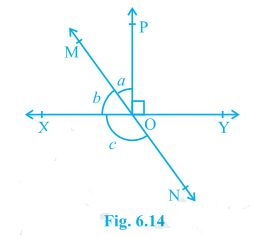
Solution:
We know that the sum of linear pair are always equal to 180°
So,
POY +a +b = 180°
Putting the value of POY = 90° (as given in the question) we get,
a+b = 90°
Now, it is given that a : b = 2 : 3 so,
Let a be 2x and b be 3x
∴ 2x+3x = 90°
Solving this we get
5x = 90°
So, x = 18°
∴ a = 2×18° = 36°
Similarly, b can be calculated and the value will be
b = 3×18° = 54°
From the diagram, b+c also forms a straight angle so,
b+c = 180°
c+54° = 180°
∴ c = 126°
3. In Fig. 6.15, PQR = PRQ, then prove that PQS = PRT.

Solution:
Since ST is a straight line so,
∠PQS+∠PQR = 180° (linear pair) and
∠PRT+∠PRQ = 180° (linear pair)
Now, ∠PQS + ∠PQR = ∠PRT+∠PRQ = 180°
Since ∠PQR =∠PRQ (as given in the question)
∠PQS = ∠PRT. (Hence proved).
4. In Fig. 6.16, if x+y = w+z, then prove that AOB is a line.
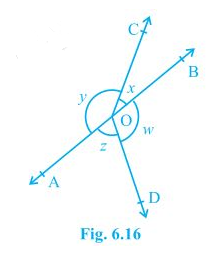
Solution:
For proving AOB is a straight line, we will have to prove x+y is a linear pair
i.e. x+y = 180°
We know that the angles around a point are 360° so,
x+y+w+z = 360°
In the question, it is given that,
x+y = w+z
So, (x+y)+(x+y) = 360°
2(x+y) = 360°
∴ (x+y) = 180° (Hence proved).
5. In Fig. 6.17, POQ is a line. Ray OR is perpendicular to line PQ. OS is another ray lying between rays OP and OR. Prove that ROS = ½ (QOS – POS).
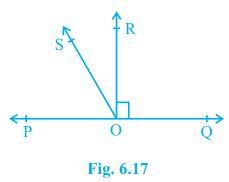
Solution:
In the question, it is given that (OR ⊥ PQ) and POQ = 180°
So, POS+ROS+ROQ = 180°
Now, POS+ROS = 180°- 90° (Since POR = ROQ = 90°)
∴ POS + ROS = 90°
Now, QOS = ROQ+ROS
It is given that ROQ = 90°,
∴ QOS = 90° +ROS
Or, QOS – ROS = 90°
As POS + ROS = 90° and QOS – ROS = 90°, we get
POS + ROS = QOS – ROS
2 ROS + POS = QOS
Or, ROS = ½ (QOS – POS) (Hence proved).
6. It is given that XYZ = 64° and XY is produced to point P. Draw a figure from the given information. If ray YQ bisects ZYP, find XYQ and reflex QYP.
Solution:
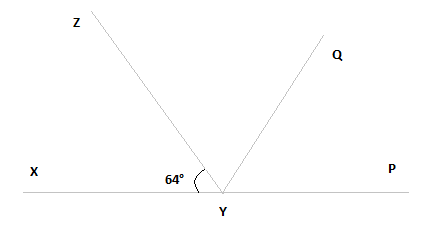
Here, XP is a straight line
So, XYZ +ZYP = 180°
Putting the value of XYZ = 64° we get,
64° +ZYP = 180°
∴ ZYP = 116°
From the diagram, we also know that ZYP = ZYQ + QYP
Now, as YQ bisects ZYP,
ZYQ = QYP
Or, ZYP = 2ZYQ
∴ ZYQ = QYP = 58°
Again, XYQ = XYZ + ZYQ
By putting the value of XYZ = 64° and ZYQ = 58° we get.
XYQ = 64°+58°
Or, XYQ = 122°
Now, reflex QYP = 180°+XYQ
We computed that the value of XYQ = 122°.
So,
QYP = 180°+122°
∴ QYP = 302°
Exercise: 6.2 (Page No: 103)
1. In Fig. 6.28, find the values of x and y and then show that AB CD.

Solution:
We know that a linear pair is equal to 180°.
So, x+50° = 180°
∴ x = 130°
We also know that vertically opposite angles are equal.
So, y = 130°
In two parallel lines, the alternate interior angles are equal. In this,
x = y = 130°
This proves that alternate interior angles are equal and so, AB CD.
2. In Fig. 6.29, if AB CD, CD EF and y : z = 3 : 7, find x.

Solution:
It is known that AB CD and CDEF
As the angles on the same side of a transversal line sums up to 180°,
x + y = 180° —–(i)
Also,
O = z (Since they are corresponding angles)
and, y +O = 180° (Since they are a linear pair)
So, y+z = 180°
Now, let y = 3w and hence, z = 7w (As y : z = 3 : 7)
∴ 3w+7w = 180°
Or, 10 w = 180°
So, w = 18°
Now, y = 3×18° = 54°
and, z = 7×18° = 126°
Now, angle x can be calculated from equation (i)
x+y = 180°
Or, x+54° = 180°
∴ x = 126°
3. In Fig. 6.30, if AB CD, EF ⊥ CD and GED = 126°, find AGE, GEF and FGE.
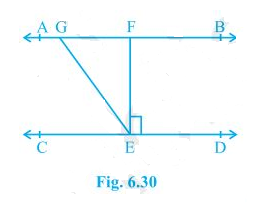
Solution:
Since AB CD, GE is a transversal.
It is given that GED = 126°
So, GED = AGE = 126° (As they are alternate interior angles)
Also,
GED = GEF +FED
As EF⊥ CD, FED = 90°
∴ GED = GEF+90°
Or, GEF = 126° – 90° = 36°
Again, FGE +GED = 180° (Transversal)
Putting the value of GED = 126° we get,
FGE = 54°
So,
AGE = 126°
GEF = 36° and
FGE = 54°
4. In Fig. 6.31, if PQ ST, PQR = 110° and RST = 130°, find QRS.
[Hint : Draw a line parallel to ST through point R.]

Solution:
First, construct a line XY parallel to PQ.
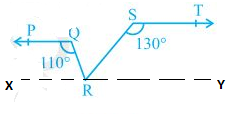
We know that the angles on the same side of transversal is equal to 180°.
So, PQR+QRX = 180°
Or,QRX = 180°-110°
∴ QRX = 70°
Similarly,
RST +SRY = 180°
Or, SRY = 180°- 130°
∴ SRY = 50°
Now, for the linear pairs on the line XY-
QRX+QRS+SRY = 180°
Putting their respective values, we get,
QRS = 180° – 70° – 50°
Hence, QRS = 60°
5. In Fig. 6.32, if AB CD, APQ = 50° and PRD = 127°, find x and y.
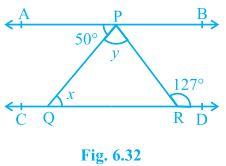
Solution:
From the diagram,
APQ = PQR (Alternate interior angles)
Now, putting the value of APQ = 50° and PQR = x we get,
x = 50°
Also,
APR = PRD (Alternate interior angles)
Or, APR = 127° (As it is given that PRD = 127°)
We know that
APR = APQ+QPR
Now, putting values of QPR = y and APR = 127° we get,
127° = 50°+ y
Or, y = 77°
Thus, the values of x and y are calculated as:
x = 50° and y = 77°
6. In Fig. 6.33, PQ and RS are two mirrors placed parallel to each other. An incident ray AB strikes the mirror PQ at B, the reflected ray moves along the path BC and strikes the mirror RS at C and again reflects back along CD. Prove that AB CD.
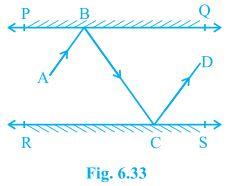
Solution:
First, draw two lines BE and CF such that BE ⊥ PQ and CF ⊥ RS.
Now, since PQ RS,
So, BE CF
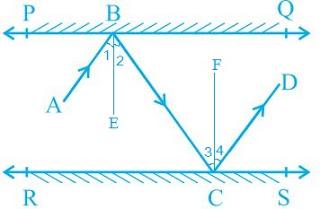
We know that,
Angle of incidence = Angle of reflection (By the law of reflection)
So,
1 = 2 and
3 = 4
We also know that alternate interior angles are equal. Here, BE ⊥ CF and the transversal line BC cuts them at B and C
So, 2 = 3 (As they are alternate interior angles)
Now, 1 +2 = 3 +4
Or, ABC = DCB
So, AB CD alternate interior angles are equal)
Exercise: 6.3 (Page No: 107)
1. In Fig. 6.39, sides QP and RQ of ΔPQR are produced to points S and T respectively. If SPR = 135° and PQT = 110°, find PRQ.
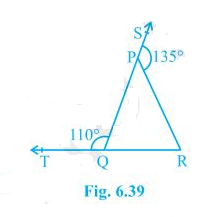
Solution:
It is given the TQR is a straight line and so, the linear pairs (i.e. TQP and PQR) will add up to 180°
So, TQP +PQR = 180°
Now, putting the value of TQP = 110° we get,
PQR = 70°
Consider the ΔPQR,
Here, the side QP is extended to S and so, SPR forms the exterior angle.
Thus, SPR (SPR = 135°) is equal to the sum of interior opposite angles. (Triangle property)
Or, PQR +PRQ = 135°
Now, putting the value of PQR = 70° we get,
PRQ = 135°-70°
Hence, PRQ = 65°
2. In Fig. 6.40, X = 62°, XYZ = 54°. If YO and ZO are the bisectors of XYZ and XZY respectively of Δ XYZ, find OZY and YOZ.
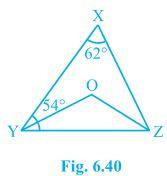
Solution:
We know that the sum of the interior angles of the triangle.
So, X +XYZ +XZY = 180°
Putting the values as given in the question we get,
62°+54° +XZY = 180°
Or, XZY = 64°
Now, we know that ZO is the bisector so,
OZY = ½ XZY
∴ OZY = 32°
Similarly, YO is a bisector and so,
OYZ = ½ XYZ
Or, OYZ = 27° (As XYZ = 54°)
Now, as the sum of the interior angles of the triangle,
OZY +OYZ +O = 180°
Putting their respective values, we get,
O = 180°-32°-27°
Hence, O = 121°
3. In Fig. 6.41, if AB DE, BAC = 35° and CDE = 53°, find DCE.
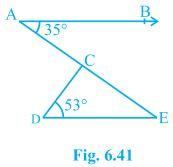
Solution:
We know that AE is a transversal since AB DE
Here BAC and AED are alternate interior angles.
Hence, BAC = AED
It is given that BAC = 35°
AED = 35°
Now consider the triangle CDE. We know that the sum of the interior angles of a triangle is 180°.
∴ DCE+CED+CDE = 180°
Putting the values, we get
DCE+35°+53° = 180°
Hence, DCE = 92°
4. In Fig. 6.42, if lines PQ and RS intersect at point T, such that PRT = 40°, RPT = 95° and TSQ = 75°, find SQT.
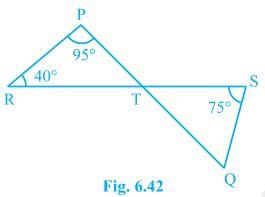
Solution:
Consider triangle PRT.
PRT +RPT + PTR = 180°
So, PTR = 45°
Now PTR will be equal to STQ as they are vertically opposite angles.
So, PTR = STQ = 45°
Again, in triangle STQ,
TSQ +PTR + SQT = 180°
Solving this we get,
SQT = 60°
5. In Fig. 6.43, if PQ ⊥ PS, PQ SR, SQR = 28° and QRT = 65°, then find the values of x and y.
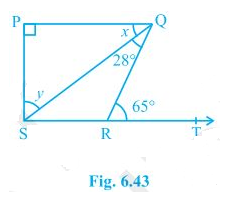
Solution:
x +SQR = QRT (As they are alternate angles since QR is transversal)
So, x+28° = 65°
∴ x = 37°
It is also known that alternate interior angles are same and so,
QSR = x = 37°
Also, Now,
QRS +QRT = 180° (As they are a Linear pair)
Or, QRS+65° = 180°
So, QRS = 115°
Now, we know that the sum of the angles in a quadrilateral is 360°. So,
P +Q+R+S = 360°
Putting their respective values, we get,
S = 360°-90°-65°-115°
In Δ SPQ
∠SPQ + x + y = 1800
900 + 370 + y = 1800
y = 1800 – 1270 = 530
Hence, y = 53°
6. In Fig. 6.44, the side QR of ΔPQR is produced to a point S. If the bisectors of PQR and PRS meet at point T, then prove that QTR = ½ QPR.
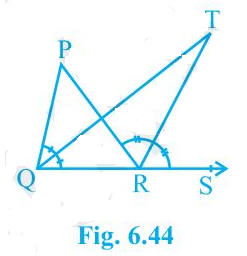
Solution:
Consider the ΔPQR. PRS is the exterior angle and QPR and PQR are interior angles.
So, PRS = QPR+PQR (According to triangle property)
Or, PRS -PQR = QPR ———–(i)
Now, consider the ΔQRT,
TRS = TQR+QTR
Or, QTR = TRS-TQR
We know that QT and RT bisect PQR and PRS respectively.
So, PRS = 2 TRS and PQR = 2TQR
Now, QTR = ½ PRS – ½PQR
Or, QTR = ½ (PRS -PQR)
From (i) we know that PRS -PQR = QPR
So, QTR = ½ QPR (hence proved).



